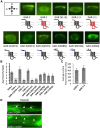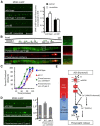Extrasynaptic muscarinic acetylcholine receptors on neuronal cell bodies regulate presynaptic function in Caenorhabditis elegans
- PMID: 23986249
- PMCID: PMC3756759
- DOI: 10.1523/JNEUROSCI.1359-13.2013
Extrasynaptic muscarinic acetylcholine receptors on neuronal cell bodies regulate presynaptic function in Caenorhabditis elegans
Abstract
Acetylcholine (ACh) is a potent neuromodulator in the brain, and its effects on cognition and memory formation are largely performed through muscarinic acetylcholine receptors (mAChRs). mAChRs are often preferentially distributed on specialized membrane regions in neurons, but the significance of mAChR localization in modulating neuronal function is not known. Here we show that the Caenorhabditis elegans homolog of the M1/M3/M5 family of mAChRs, gar-3, is expressed in cholinergic motor neurons, and GAR-3-GFP fusion proteins localize to cell bodies where they are enriched at extrasynaptic regions that are in contact with the basal lamina. The GAR-3 N-terminal extracellular domain is necessary and sufficient for this asymmetric distribution, and mutation of a predicted N-linked glycosylation site within the N-terminus disrupts GAR-3-GFP localization. In transgenic animals expressing GAR-3 variants that are no longer asymmetrically localized, synaptic transmission at neuromuscular junctions is impaired and there is a reduction in the abundance of the presynaptic protein sphingosine kinase at release sites. Finally, GAR-3 can be activated by endogenously produced ACh released from neurons that do not directly contact cholinergic motor neurons. Together, our results suggest that humoral activation of asymmetrically localized mAChRs by ACh is an evolutionarily conserved mechanism by which ACh modulates neuronal function.
Figures







Similar articles
-
Extrasynaptic acetylcholine signaling through a muscarinic receptor regulates cell migration.Proc Natl Acad Sci U S A. 2021 Jan 5;118(1):e1904338118. doi: 10.1073/pnas.1904338118. Proc Natl Acad Sci U S A. 2021. PMID: 33361149 Free PMC article.
-
Recruitment of sphingosine kinase to presynaptic terminals by a conserved muscarinic signaling pathway promotes neurotransmitter release.Genes Dev. 2012 May 15;26(10):1070-85. doi: 10.1101/gad.188003.112. Genes Dev. 2012. PMID: 22588719 Free PMC article.
-
Cross Talk with the GAR-3 Receptor Contributes to Feeding Defects in Caenorhabditis elegans eat-2 Mutants.Genetics. 2019 May;212(1):231-243. doi: 10.1534/genetics.119.302053. Epub 2019 Mar 21. Genetics. 2019. PMID: 30898771 Free PMC article.
-
Presynaptic membrane receptors in acetylcholine release modulation in the neuromuscular synapse.J Neurosci Res. 2014 May;92(5):543-54. doi: 10.1002/jnr.23346. Epub 2014 Jan 27. J Neurosci Res. 2014. PMID: 24464361 Review.
-
Cholinergic and Adenosinergic Modulation of Synaptic Release.Neuroscience. 2021 Feb 21;456:114-130. doi: 10.1016/j.neuroscience.2020.06.006. Epub 2020 Jun 13. Neuroscience. 2021. PMID: 32540364 Review.
Cited by
-
NeuroPAL: A Multicolor Atlas for Whole-Brain Neuronal Identification in C. elegans.Cell. 2021 Jan 7;184(1):272-288.e11. doi: 10.1016/j.cell.2020.12.012. Epub 2020 Dec 29. Cell. 2021. PMID: 33378642 Free PMC article.
-
Extrasynaptic acetylcholine signaling through a muscarinic receptor regulates cell migration.Proc Natl Acad Sci U S A. 2021 Jan 5;118(1):e1904338118. doi: 10.1073/pnas.1904338118. Proc Natl Acad Sci U S A. 2021. PMID: 33361149 Free PMC article.
-
Pharmacological Profiling of a Brugia malayi Muscarinic Acetylcholine Receptor as a Putative Antiparasitic Target.Antimicrob Agents Chemother. 2023 Jan 24;67(1):e0118822. doi: 10.1128/aac.01188-22. Epub 2023 Jan 5. Antimicrob Agents Chemother. 2023. PMID: 36602350 Free PMC article.
-
Chemical activation of a food deprivation signal extends lifespan.Aging Cell. 2016 Oct;15(5):832-41. doi: 10.1111/acel.12492. Epub 2016 May 24. Aging Cell. 2016. PMID: 27220516 Free PMC article.
-
Neurotransmitter signaling through heterotrimeric G proteins: insights from studies in C. elegans.WormBook. 2018 Dec 11;2018:1-52. doi: 10.1895/wormbook.1.75.2. WormBook. 2018. PMID: 26937633 Free PMC article. Review.
References
Publication types
MeSH terms
Substances
Grants and funding
LinkOut - more resources
Full Text Sources
Other Literature Sources
